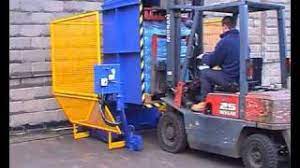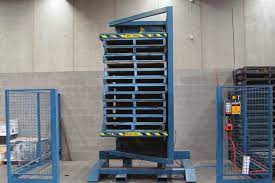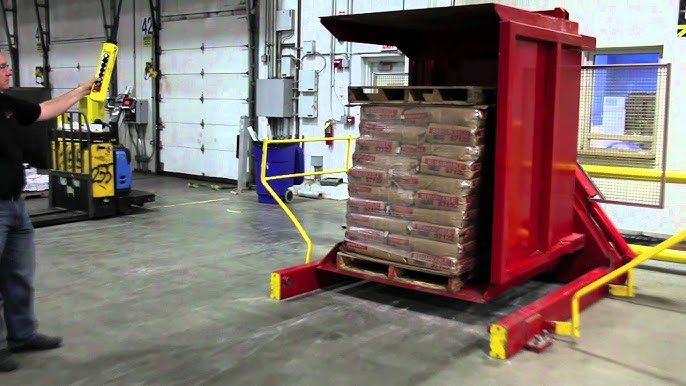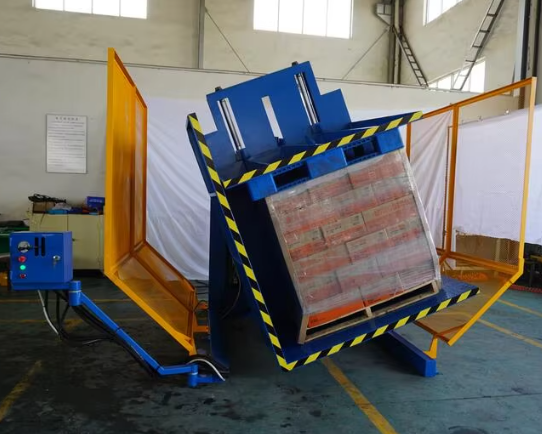What’s the ROI of Automated Pallet Changing Machines in United States's OSHA Sector?
Are you constantly battling rising operational costs in your U.S. facility? Do you worry about the safety of your team during manual material handling? I've been there. In my years as an engineer and later as a factory owner, I saw how a single workplace injury could impact not just a person's life, but the entire production line's morale and finances. You're pressured to improve efficiency and protect your people, all while keeping a close eye on the bottom line. It feels like a difficult balancing act, but what if a single investment could address both safety and profitability?
The return on investment (ROI) for an automated pallet changing machine in the United States is significant, typically showing a payback period of 12 to 24 months. This return is driven by three main factors: drastic reductions in labor costs, a near-elimination of product damage during transfer, and minimized risks of OSHA-related fines and workers' compensation claims associated with manual handling.

I understand that any new equipment purchase requires a serious look at the numbers. You need more than just a vague promise of "improvement." You need to see a clear path from investment to return. In this article, I will break down the real, measurable value of these machines. We'll go beyond the sticker price and look at how automation impacts your insurance premiums, your throughput, and your ability to compete. Let's explore how to calculate this ROI for your specific operation.
How Do Automated Pallet Changers Directly Impact OSHA Compliance and Reduce Workplace Injuries?
Do you ever review your incident reports and see the same pattern? Back strains, sprains, and repetitive motion injuries from lifting and moving heavy loads. These are not just statistics; they are your people. The financial cost of these injuries is high, from medical bills to lost productivity. But the regulatory pressure from the Occupational Safety and Health Administration (OSHA) adds another layer of risk. A single serious violation can lead to heavy fines and mandatory, expensive changes to your processes.
Automated pallet changers directly address the root cause of most manual material handling injuries by removing the person from the hazardous task. These machines safely and efficiently transfer entire loads from one pallet to another, eliminating the need for employees to manually lift, bend, twist, and carry heavy items. This directly aligns with OSHA's guidelines for ergonomic safety, significantly lowering your risk of citations and fines related to musculoskeletal disorders (MSDs), which are among the most common and costly workplace injuries in the United States.

Breaking Down the OSHA Connection
Let's get specific. OSHA's General Duty Clause, Section 5(a)(1), requires employers to provide a workplace "free from recognized hazards that are causing or are likely to cause death or serious physical harm." Manual restacking of heavy pallet loads is a well-recognized hazard. When an inspector sees workers physically struggling with loads, it's a major red flag. An automated pallet inverter or exchanger is a definitive engineering control. It's a clear demonstration to OSHA that you have taken proactive steps to eliminate the hazard, not just provide personal protective equipment or administrative controls like job rotation. This is the highest level of hazard control and is viewed most favorably by regulators.
The True Cost of a Workplace Injury
The direct costs of an injury are easy to see: workers' compensation payments and medical bills. But the indirect costs are often four to ten times greater. Think about it. When a skilled worker is injured, you have to account for:
- Lost Productivity: The injured employee is out. Production might slow or stop.
- Replacement Costs: You may need to hire and train a temporary or new employee.
- Administrative Time: Your supervisors and HR staff spend hours on paperwork and investigation.
- Morale: An injury can create fear and anxiety among other team members, hurting overall productivity.
- Insurance Premiums: Your Experience Modification Rate (EMR) will likely increase after a claim, raising your workers' compensation insurance costs for years.
An automated pallet changer mitigates all these risks. It's a one-time investment that pays dividends year after year by creating a safer, more stable, and more compliant work environment. It's not just about avoiding fines; it's about building a more resilient and responsible operation.
What Are the Key Cost Savings and Revenue Gains from Implementing Pallet Exchangers?
You're running a business, and every piece of equipment must justify its existence financially. You might see a pallet exchanger and think, "That's a nice piece of tech, but what will it actually do for my profit and loss statement?" It's a fair question. The initial cost can seem high, so the benefits need to be concrete and measurable. Too often, I see companies focus only on the labor savings, but that's just the tip of the iceberg.
The key financial benefits of a pallet exchanger are categorized into direct cost savings and new revenue opportunities. Direct savings come from dramatically reduced manual labor hours, a drop in product damage rates to almost zero, and lower spending on premium or specialized pallets. At the same time, revenue gains are realized through increased throughput and the ability to accept orders from clients with different pallet requirements, opening up new markets without adding operational complexity.

A Deeper Dive into the Financials
Let's put some numbers to these concepts. Imagine a typical scenario where a two-person team manually transfers a pallet load. This process is not only slow but also risky for both your people and your products.
Direct Cost Savings
- Labor Costs: Manual transfer is slow. A two-person team might take 15-20 minutes per pallet. An automated pallet exchanger can do the same job in under 60 seconds with one operator supervising. You're not just saving on salaries; you're reallocating valuable human resources to more complex, value-added tasks.
- Product Damage: When people are lifting and moving individual boxes or bags, things get dropped, crushed, or damaged. Even a modest 1% damage rate can add up to thousands of dollars in lost product and disposal fees over a year. Automation handles the entire load as a single, stable unit. This reduces damage rates to a fraction of a percent.
- Pallet Management: Are you forced to buy expensive plastic pallets for your internal, hygienic-controlled loops? Do you lose high-quality wooden pallets when you ship products out? A pallet exchanger allows you to keep your premium pallets in-house. You can transfer finished goods to cheaper, one-way shipping pallets right before they go on the truck. The savings on pallet purchasing alone can be substantial.
Revenue and Throughput Gains
- Increased Throughput: Speed equals capacity. If your pallet transfer process is a bottleneck, you can't ship products any faster. By automating this step, you increase the overall speed of your entire shipping or receiving department. This means you can process more orders in the same amount of time with the same number of people.
- Market Flexibility: What happens when a big potential customer in the United States requires products on a specific type of pallet that you don't use? Manually restacking is slow and expensive. Many companies might even turn down the business. With a pallet exchanger, you can say "yes" to any customer, regardless of their pallet standard. This flexibility opens doors to new revenue streams and makes you a more agile and attractive supplier.
Here is a simplified comparison:
| Metric | Manual Transfer (2 Workers) | Automated Pallet Exchanger (1 Operator) | Annual Impact (Assuming 20 Pallets/Day) |
|---|---|---|---|
| Time per Pallet | 20 minutes | 1 minute | Reclaims ~1150 labor hours/year |
| Labor Cost/Pallet | ~$16.67 (@ $25/hr/worker) | ~$0.42 (@ $25/hr/operator) | ~$81,250 in direct labor savings |
| Product Damage Rate | 1% - 3% | < 0.1% | Saves thousands in written-off goods |
| Throughput | 3 pallets/hour | Up to 60 pallets/hour | Eliminates shipping bottlenecks |
| Flexibility | Low (Difficult to change pallet type) | High (Easily switch pallet types) | Unlocks new customer markets |
When you look at the full picture, a pallet exchanger is not just a cost-saving device. It's a tool for growth.
How Can You Accurately Calculate the Payback Period for a Pallet Inverter?
Okay, we've talked about the benefits in safety and cost savings. But if you're going to convince your board or your financial controller, you need a solid number. You need to answer the question: "If we spend X dollars on this machine, how many months will it take to get that money back?" This is the payback period, and a clear, conservative calculation is your most powerful tool for justifying the investment. Guesswork won't cut it.
To accurately calculate the payback period for a pallet inverter, you must first sum up all the quantifiable monthly savings the machine will generate. This includes direct labor savings, reduced product damage costs, and savings on pallet purchasing. Then, you divide the total initial investment (including purchase price, shipping, and installation) by this total monthly savings figure. The result is the number of months required for the machine to pay for itself.

A Step-by-Step Calculation Guide
Let's walk through this process with realistic numbers that I've seen with my clients in the United States. Don't just copy these numbers; use this framework to plug in your own data for a true-to-life estimate.
Step 1: Calculate Total Initial Investment
This is more than just the price on the quote. Be thorough.
- Machine Cost: $50,000
- Shipping & Freight: $3,000
- Installation & Commissioning: $5,000
- Initial Operator Training: $1,000
- Total Initial Investment (A): $59,000
Step 2: Calculate Total Monthly Savings
This is where you need to be honest and use your actual operational data.
- Labor Savings:
- Workers involved in manual transfer: 2
- Hourly wage (fully burdened): $25/hour
- Time per manual transfer: 15 minutes (0.25 hours)
- Pallets transferred per day: 30
- Calculation: 2 workers $25/hr 0.25 hr/pallet 30 pallets/day 21 working days/month = $7,875/month
- Product Damage Reduction:
- Average value of a pallet load: $2,000
- Manual damage rate: 1.5%
- Pallets transferred per month: 630 (30/day * 21 days)
- Calculation: 630 pallets $2,000/pallet 1.5% damage = $18,900 in damaged goods value. Let's assume automation reduces this by 90%.
- Monthly Savings: $18,900 * 90% = $17,010/month (Note: This can be a huge number depending on your product value)
- Pallet Cost Savings:
- You switch 30 pallets/day from premium in-house pallets ($40) to cheap shipping pallets ($12).
- Calculation: ($40 - $12) 30 pallets/day 21 days/month = $17,640/month
Let's use a more conservative estimate for our final calculation, as product value and pallet costs can vary wildly. We'll focus primarily on the most predictable saving: labor. Let's add a very conservative $1,000/month for combined damage and pallet savings.
- Total Monthly Savings (B): $7,875 (Labor) + $1,000 (Damage/Pallet) = $8,875/month
Step 3: Calculate the Payback Period
- Payback Period (in months) = Total Investment (A) / Total Monthly Savings (B)
- Calculation: $59,000 / $8,875 = 6.65 months
Even with conservative estimates, the payback period is often less than a year. Presenting a clear, step-by-step calculation like this demonstrates that you've done your homework and that this investment is based on sound financial logic.
My Insights
I remember visiting a potential client a few years ago, a man named Javier who ran a large steel mill. He was sharp, a true expert in his field, and he reminded me a lot of myself when I was first growing my own factory. He was under immense pressure. His equipment was aging, energy costs were unpredictable, and he was skeptical about new technology. His main concern was downtime. "Vincent," he said, "I can't afford to stop my line to install a new machine that might not work with my old systems. My biggest challenge is keeping things moving."
He showed me his packaging area. Two strong men were manually unstacking 50-pound sacks of a granulated alloy from one pallet and restacking them onto a different pallet for a specific customer. It was slow, hard work. I saw one of the men wince as he twisted to place a bag. I knew that was a future workers' compensation claim waiting to happen.
Javier saw it too. He was a good boss who cared about his people. But he was focused on the capital cost and the risk of integration. He said, "The ROI calculation looks good on paper, but what about the hidden problems?"
This is a fear I understand completely. It's not just about the machine; it's about the partnership. I told him, "Javier, we don't just sell you a box and leave. Our goal is to be your total solution partner. We will send our engineers to your site. We will study your existing line—your conveyors, your wrappers, everything. We will design the integration plan with you, ensuring it fits perfectly. We will install it over a weekend, so you don't lose a single hour of production. And we will train your team until they are experts."
We spent the next month working on that plan. We found a way to place the pallet inverter that required minimal changes to his existing layout. We proved that the machine was simple to operate and maintain. He finally agreed.
Six months later, I called him. The first thing he said was, "Vincent, the machine paid for itself already." The two men who used to do that back-breaking work were now trained as quality control technicians, a more valuable and safer role. His throughput in that section had tripled, completely eliminating a bottleneck he didn't even realize was so severe. Most importantly, he told me his OSHA recordable incident rate had dropped. "It's not just about the money," he said. "It's about peace of mind." That, for me, is the real return on investment. It's building a safer, stronger, and more successful business.
Conclusion
Ultimately, investing in an automated pallet changing machine is a strategic move. It strengthens your business by boosting safety, cutting operational costs, and increasing your overall efficiency and market flexibility.




